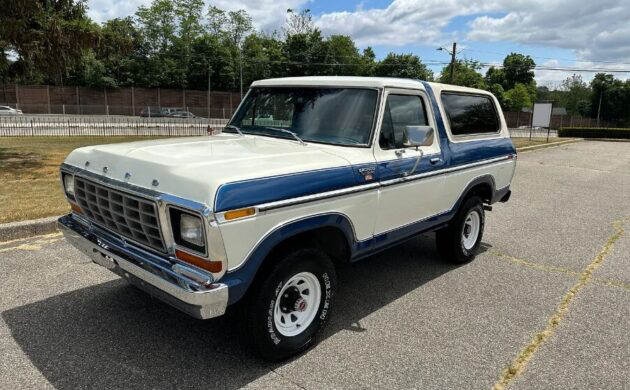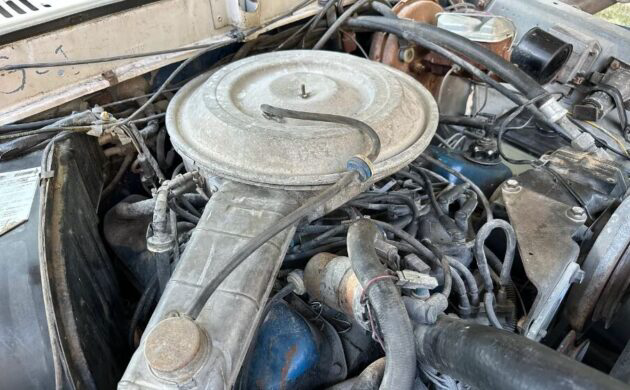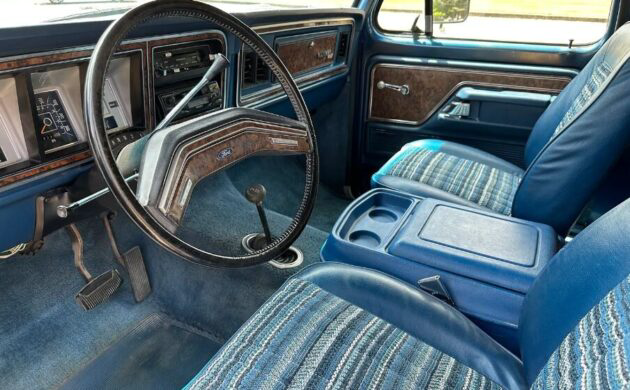Ford could have been forgiven if it had retired the Bronco badge following the end of First Generation production in 1977. However, it persisted, and the company found itself with a hit due to Second Generation sales figures. This 1979 Bronco Ranger XLT presents well for its age, but its ace could be the enormous selection of options chosen by its original owner. It carries the hallmarks of a vehicle that has always been treated respectfully, and it is now time for a new owner to reap the benefits of that care. The Bronco is listed here on eBay in Ramsey, New Jersey. Frantic action has pushed the price to $35,201, although that remains below the reserve.
The styling of the First Generation Bronco looked dated when Ford put it out to pasture, but the Second Generation looked significantly more modern and had a greater presence. This one wears a stunning combination of Wimbledon White and Dark Metallic Blue paint. It provides a classy appearance, with the seller describing it as “like glass.” The depth of shine is impressive, and the close-up shots reveal no significant defects. The panels are straight, and the only rust of note is some surface corrosion on the Bronco’s underside. None looks ready to cause steel penetration, but treating it before it reaches that point would be wise. The fiberglass top and glass are flawless, as is the chrome. The XLT rolls on larger wheels and new tires, and although I prefer originality, they undoubtedly provide a sense of purpose and suit the vehicle’s styling.
Buyers could choose between two engines to power their new ’79 Bronco, but this classic’s original owner went straight for the range-topping 400ci V8. The rest of the drivetrain includes a three-speed automatic transmission, a dual-range transfer case, a 3.50 Traction-Lok rear end, power steering, and power brakes. The listing confirms the original owner equipped this beauty with skid plates, a reduced noise exhaust, a Light Duty Tow Package, the Handling Package, a transmission cooler, and a heavy-duty radiator. Outright performance wasn’t a key consideration for most buyers, but they undoubtedly welcomed the fact their new toy could cruise all day at freeway speeds. However, with most of the engine’s power and torque delivered below 2,000rpm, these Broncos were accomplished tow vehicles that came into their own crawling over harsh terrain. Potential buyers seeking a turnkey escape vehicle will probably decide this Bronco ticks the boxes. It runs and drives well, with plenty of engine power and a smooth transmission.
Vehicles of this type and age often feature tired and stained interiors, but this Bronco looks surprisingly good. The carpet is slightly stained, primarily under the driver’s feet. Otherwise, there is little to criticize. The multi-hue Blue cloth and vinyl seatcovers are in good order, as are the remaining upholstered surfaces. The door pockets are suffering the typical sagging issues, but I have seen owners successfully thread in new elastic to address the problem. The dash and pad are spotless, as is the faux woodgrain trim. For those preferring their off-road adventures to occur in the lap of luxury, this Ranger XLT delivers. The new owner receives air conditioning, tinted glass, a console, a tilt wheel, cruise control, an illuminated vanity mirror, a flip/fold rear seat, privacy glass, and an AM/FM stereo radio/cassette player.
Ford must have wondered whether it had backed a loser with its First Generation Bronco because only once did sales figures top 25,000 during twelve years in the showroom. The Second Generation proved a different animal; this vehicle is 1-of-104,038 to find a buyer in 1979. That proves how popular these classics were when new, and that hasn’t changed in the decades since. This Bronco Range XLT has attracted an incredible eighty-six bids, and with four days remaining on the auction, there is scope for the bid total and price to both climb substantially. What do you think the figure will be when the hammer falls? It will be fascinating to see if any readers can hit the nail on the head with this stunning beast.







Yup good engines pull just about anything you want – but ya can’t pass a gas station🤣
On another note every 1/2 ton full size 4×4 truck in ‘79 wandered they all used the Dana 44 front axle normal maintenance with larger than stock tires was fill the gas, check the oil and change the spindle bearings. It’s a good thing that the 44 is an easy axle to work on.
A 1978-1979 Bronco with a 351/400M should have a C6 transmission, not a C4. The C4 was used behind the 289/302 engines.
Correct – no C4s behind 351Ms in the F150s either.
You’re lucky! The 351M in our ’77 F250 died at about 75K with a burnt valve. A 400 replaced it and unfortunately that thing drank a quart of oil about every 300 miles. Dad still gets pissed talking about it – the mechanic at his repair shop strung it along until it was out of warranty..
The biggest reason why the Ford light duty trucks of this era had wandering steering was because of their “better idea” twin traction beam front ends, that effected the 4×4 and 4×2’s! Especially if you tried to tow anything heavy with no weight distribution hitch, that allowed the front end to rise higher than the rear, that would leave the front end alignment all wrong, with terrible bump steer as a secondary awful effect! I remember my family had a heavy wooden boat, one of us would bring down to the water each summer, then out in the fall. At 9,000 lbs total to tow, between a 1985 F150 reg cab short bed 4×4, 300 straight six 5 speed, or 1986 Dodge D100 4×2 reg cab slant six automatic. The F150 had a power advantage, but was actually dangerous wandering all over the road! The D100 on the other hand towed straight an true, pulling even the toughest hills at the 55 mph limits, granted in second gear only. The D100 also had better brakes, as the big trailer had none.
I guess I’m missing your point how does weight distribution change alignment on a straight axle?
Because the F150 I mentioned had the Ford Twin Traction Front axle, that wasn’t a one piece straight design. That was an attempt to blend the strengths of a straight axle with the traction and independent wheel travel of an independent suspension system. That when you added a lot of weight in the back, like enough to lift the type of twin traction beam front end in the F150 and some F250 and F350’s, because of the pivot in the center the wheels hang at an angle that brings the bottoms in closer together, that in turn effects the toe-in and toe-out, plus induces what’s called bump steer. That’s why when towing heavy the truck was all over the road, because the steering geometry gets all weird.
The 78-79 broncos are actually a solid axle high pinion dana 44 up front and a 9 inch in the rear. In 1980 is when the 4wd half ton trucks and broncos when to twin I beam.
78/79 broncos have solid front axle.
Colors plus options plus conditions = $50-60k .Let’s say $ 58,400.oo
Loved the body style , had to have one. Ordered a new Bronco all Black XLT,400,3:50 posi, Black Captains Bucket seat, with Rollbar, Tinted rear side glass, Quadra shock, large 40 gal fuel tank . 10 mile to gal if you drove 55 or 80. Stickered $11,646.00, drove one year and couldn’t stand the tire noise from the rough tread B F Goodrich All-Terrain tires. I wished I had my 78 F150 4×4 back that I sold my Father. Like to have it back today with the 11,000. miles it had on it.
It’s a beautiful truck in what looks like excellent condition. Don’t see them this nice except at shows or auctions, which is likely where this Bronco will end up. The seller likely wants 50k at least. Want to get your 50k show truck full of mud?